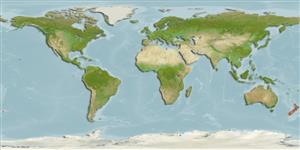Common names from other countries
Teleostei (teleosts) >
Gobiesociformes (Clingfishes) >
Gobiesocidae (Clingfishes and singleslits) > Trachelochisminae
Etymology: Trachelochismus: Greek, trachelos = neck + Greek, schismos, -ou = cut (Ref. 45335).
More on author: Forster.
Environment: milieu / climate zone / depth range / distribution range
Ecology
Marine; demersal; depth range 0 - 70 m (Ref. 116173). Temperate
Southwest Pacific: endemic to New Zealand.
Size / Weight / Age
Maturity: Lm ? range ? - ? cm
Max length : 10.0 cm TL male/unsexed; (Ref. 9003)
Short description
Identification keys | Morphology | Morphometrics
Dorsal spines (total): 0; Dorsal soft rays (total): 7 - 9; Anal spines: 0; Anal soft rays: 5 - 7. Pink to red or green dorsally, possibly with longitudinal bands of brown, or spotted brown and yellow. Occasionally with patches of pink over the dorsal surface. Pale creamy white ventrally. Distinguished from other clingfishes by the broad, bluntly pointed head, a thick, fleshy upper lip and a longitudinal groove below the eye lined with fleshy lobes. The sucking disc lacks flattened papillae across the anterior margin.
Common in rock pools at mid to low tide and in subtidal areas. Usually found clinging under rocks of exposed areas. Feeds on small mollusks, polychaete worms, amphipods, and other crustaceans.
Life cycle and mating behavior
Maturities | Reproduction | Spawnings | Egg(s) | Fecundities | Larvae
Paulin, C. and C. Roberts, 1992. The rockpool fishes of New Zealand (Te ika aaria o Aotearoa). Museum of New Zealand (Te Papa Tongarewa). 177 p. (Ref. 9003)
IUCN Red List Status (Ref. 130435)
CITES (Ref. 128078)
Not Evaluated
Threat to humans
Harmless
Human uses
Tools
Special reports
Download XML
Internet sources
Estimates based on models
Preferred temperature (Ref.
115969): 13.8 - 19.4, mean 16.5 (based on 106 cells).
Phylogenetic diversity index (Ref.
82804): PD
50 = 0.7500 [Uniqueness, from 0.5 = low to 2.0 = high].
Bayesian length-weight: a=0.00468 (0.00180 - 0.01212), b=3.12 (2.89 - 3.35), in cm Total Length, based on LWR estimates for this (Sub)family-body shape (Ref.
93245).
Trophic level (Ref.
69278): 3.4 ±0.46 se; based on food items.
Resilience (Ref.
120179): Medium, minimum population doubling time 1.4 - 4.4 years (Preliminary K or Fecundity.).
Fishing Vulnerability (Ref.
59153): Low vulnerability (10 of 100).
